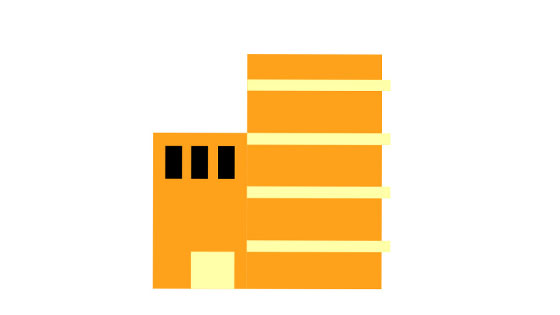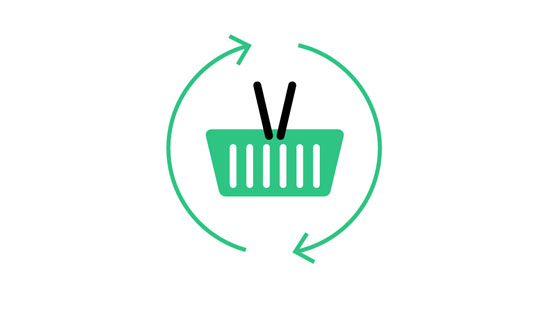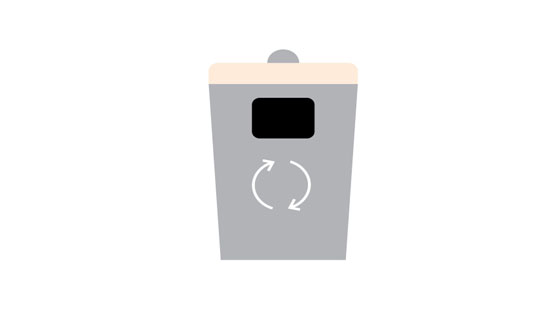UiO aims to halve greenhouse gas emissions by 2030. Here you can see how we are progressing in the different categories.
Our goals for 2030

Travel
50% cuts in emissions from business trips

Energy consumption
30% lower energy use on campus

Buildings
Sustainable maintenance and climate friendly construction

Goods
Lower, more sustainable consumption
UiO uses 2018 as a reference year.

Services
Lower, more sustainable consumption

Waste
Waste less, recycle more
Our progress 2018–2030
The climate accounts are a helpful tool to identify which of our activities contribute the most to carbon emissions. This helps us implement the most effective measures possible to reduce our emissions. The overview shows which categories have the highest emissions and how we are progressing towards our goals of reduction.
Total emissions

This graph shows the total greenhouse gas emissions at UiO from 2018 to 2022. The goal of halving emissions by 2030 is marked by a dotted line.
In 2022, we have reduced our emissions by eight percent since 2018.
Travel

UiO aims to reduce carbon emissions from business trips by half from 2018 to 2030. This includes trips made by our employees for conferences, fieldwork, and other international collaborations. The dotted line indicates the goal.
This graph shows the emissions associated with air travel. As expected, emissions from air travel has increased since the pandemic. However, compared to the reference year of 2018, we traveled less by plane in 2022, resulting in a 33 percent reduction in emissions from air travel.
Energy consumption

Energy consumption represents the emissions associated with purchased electricity and district heating. UiO aims to reduce energy consumption on campus by 30 percent by 2030. This is indicated by the dotted line on the graph.
Energy consumption accounted for approximately 26 percent of our total emissions in 2022. Thanks to systematic measures for energy efficiency, we have reduced emissions by 21 percent since 2018. Therefore, we are well on our way to achieving our goal in this category.
Buildings

The buildings category encompasses carbon emissions related to investments, renovations, leasing of properties, repairs, maintenance of buildings, waste management and cleaning. Buildings accounted for 22 percent of our carbon emissions in 2022.
In the buildings category we see an increase of 58 percent compared to 2018. This is mainly due to the completion of the renovation projects at Eilert Sundts hus and Br?ggers hus, which were only accounted for this year. These are the largest renovation projects that UiO has ever undertaken.
Waste

The waste category shows the carbon emissions for all waste generated by UiO, where cardboard and paper, residual waste, and medical waste are the largest contributors. UiO aims to waste less and recycle more. In 2022, waste accounted for one percent of our total carbon emissions.
Although the amount of waste has increased in weight, we can see from the graph that we have reduced emissions associated with waste by 17 percent since 2021. This is mainly due to the fact that we now recycle all plastic waste.
Services

The services category consists of expenses related to research and lab services, consulting services, software and subscriptions. Overall, this category accounts for eight percent of our carbon emissions in 2022.
Since 2018, we have reduced emissions from the procurement of services by 38 percent. This is partly due to a reduction in the carbon emissions from the acquisition of software and purchases of lab and research services.
Goods

The goods category includes emissions related to all purchases of goods at UiO. The largest emissions come from the purchases of scientific equipment and machinery, including audio-visual equipment and fixtures. Purchases related to the daily operation of campus is the second largest source of emissions in this category.
Goods, along with energy consumption, constitute the largest emission category, each contributing 26 percent of the total emissions in 2022. The graph shows a slight increase in emissions from goods in 2022, with an increase of one percent since 2018. This is mainly due to increased expenses related to the major renovation projects completed in 2022 (see Buildings).
Sources of emissions in 2022

Sources of greenhouse gas emissions per category at UiO in 2022:
- Goods: 26 percent
- Energy consumption: 26 percent
- Buildings: 22 percent
- Travel: 18 percent
- Services: seven percent
- Waste: one percent
The diagram has a total of 101 percent due to the conversion from decimal numbers.
Methodology
About the methodology
The UiO climate accounts are made with the help of Klimakost, a tool made to measure greenhouse gas emissions for organisations. The goal is to give an overview of what areas contribute most to our climate footprint?- and thus be able to measure the progress towards the goals we have set.
The methodology utilises calculations of accounting data multiplied by emissions factors, which are indirect emissions rather than measured direct emissions. This methodology is the same as is used when the Norwegian Environment Agency makes Norway's National Greenhouse Accounts in accordance with the guidelines from the UN Intergovernmental Panel on Climate Change.?Klimakost is also used by the City of Oslo and other universities.
Klimakost is still under development, but it is the best-developed tool we have access to at the moment in the higher education sector in Norway. We work continuously to gather and provide better data about emissions at UiO in order to create a clear picture of our total emissions. For instance, we want to gather data related to larger procurements of goods, rather than basing the data solely on economic emission factors.
About travel
Due to methodological changes in the reporting done by Klimakost, the emission figures for work-related travel in 2022 are not directly comparable to data from 2018. The 2022 report includes work-related travel booked outside of UiO's travel portal, which was not the case for the 2018 report. Therefore, UiO has adjusted the data related to work-related travel, assuming that the percentage of bookings outside the travel portal is the same as it is in 2022. By doing this, we ensure a better basis for comparison between the two years.
Previous reports
Klimagassregnskap 2018 (pdf, 1003 kb)
Klimagassregnskap 2019 (pdf, 1017 kb)
Klimagassregnskap 2020 (pdf, 1298 kb)
Klimagassregnskap 2021 (pdf, 1111 kb)
Read the report for the climate account in 2022 (pdf, 804 kb)